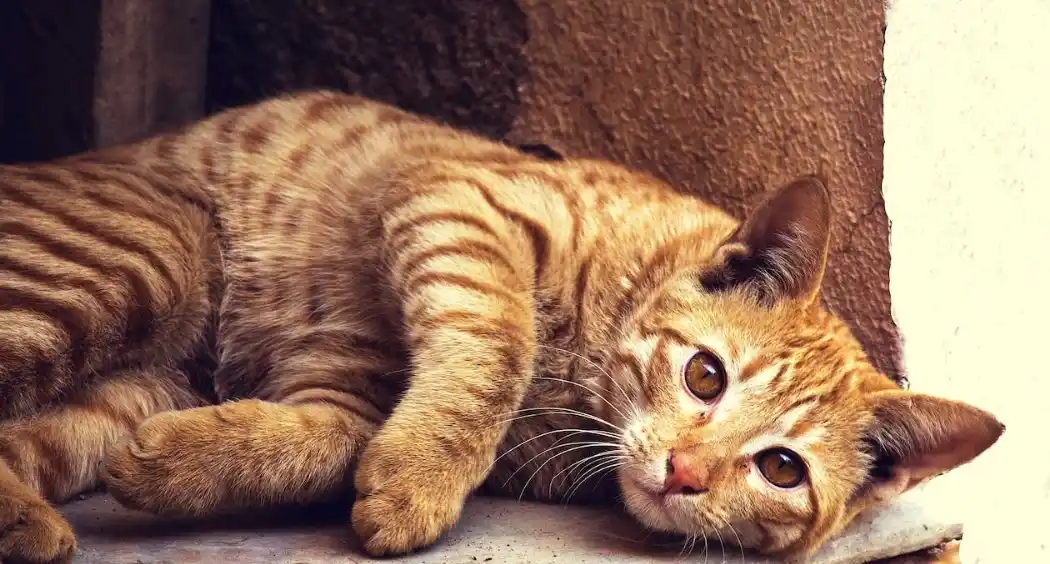Abscesses in Cats: Diagnosis, Causes, Symptoms & Treatment
Abscesses in cats are infected pockets of pus that form under the skin. They are often caused by wounds or bites and can be painful and swollen.

What is an Abscesses
Abscesses in cats are common skin infections that occur when bacteria enter a wound or bite and cause an accumulation of pus beneath the skin. They can develop anywhere on the cat's body but are frequently found around the head, neck, and limbs.
Abscesses in cats are typically characterized by a swollen, warm, and painful area with redness and possible hair loss. Cats may exhibit signs of discomfort, such as licking, biting, or avoiding the affected area. In some cases, the abscess may rupture and release pus, providing temporary relief for the cat. However, this does not mean the infection is resolved, and it is important to seek veterinary care.
To diagnose an abscess, a veterinarian will examine the affected area, looking for signs of inflammation and the presence of a pus-filled pocket. In some cases, further tests such as a bacterial culture or a fine-needle aspiration may be performed to determine the specific bacteria causing the infection.
Treatment for abscesses in cats usually involves draining the pus from the abscess. This is typically done by making a small incision and allowing the pus to drain out. The wound is then cleaned with an antiseptic solution. In many cases, the veterinarian will prescribe antibiotics to help eliminate the infection and prevent its spread.
It is crucial to have a veterinarian treat abscesses in cats as they can lead to complications if left untreated. These complications may include the infection spreading to other areas of the body, the formation of internal abscesses, or the development of a chronic infection.
Prevention of abscesses involves minimizing the risk of wounds or bites. Keeping cats indoors, providing a safe and secure environment, and preventing fights with other animals can help reduce the chances of abscesses occurring. Regular check-ups with a veterinarian can also help detect and treat any wounds or infections early on.
If you suspect that your cat has an abscess or notice any signs of infection, it is important to seek veterinary attention promptly. The veterinarian will be able to assess the abscess, provide appropriate treatment, and offer guidance on preventing future occurrences.
Cat Abscesses Symptoms
The symptoms of abscesses in cats can vary depending on the location and severity of the infection. Here are some common symptoms to watch for:
Swelling: Abscesses typically cause localized swelling at the site of infection. The swelling may appear as a lump or bump under the cat's skin.
Redness and Warmth: The area around the abscess may be red and inflamed. It may feel warm to the touch due to the presence of infection and inflammation.
Pain and Discomfort: Cats with abscesses often experience pain and discomfort. They may show signs of discomfort when the affected area is touched or may be hesitant to move or put weight on the affected limb.
Limping or Lameness: If an abscess occurs on a limb or paw, the cat may exhibit limping or lameness. This is due to the pain and inflammation caused by the infection.
Behavioral Changes: Cats with abscesses may exhibit changes in behavior. They may become more withdrawn, irritable, or aggressive, especially if the abscess is causing them pain or discomfort.
Loss of Appetite: In some cases, cats with abscesses may experience a loss of appetite. This can be a result of the underlying infection or the discomfort associated with the abscess.
Pus or Discharge: As the abscess progresses, it may begin to drain pus or other fluid. This can be seen as a discharge from the site of the abscess.
It's important to note that not all abscesses are immediately visible. Some may be located deeper under the skin or in the mouth. In such cases, the symptoms may be less apparent, but the cat may still exhibit signs of pain, discomfort, or changes in behavior.
If you notice any of these symptoms or suspect that your cat may have an abscess, it's essential to seek veterinary care. A veterinarian can properly diagnose the abscess, determine the underlying cause, and recommend appropriate treatment, which may involve draining the abscess, prescribing antibiotics, and providing pain management.
Causes of Abscesses in Cats: Understanding the Triggers of Feline Health Issues
Abscesses in cats are typically caused by bacterial infections that occur when the skin is punctured or damaged, allowing bacteria to enter and multiply. Some common causes of abscesses in cats include:
Bite Wounds: Cat fights, especially those involving outdoor or territorial cats, often result in abscesses. The puncture wounds from bites allow bacteria from the cat's mouth or the environment to enter and cause an infection.
Scratch or Claw Injuries: Deep scratches or wounds caused by sharp claws, whether from fighting or accidental scratches, can lead to abscesses if bacteria enter the wound.
Foreign Objects: When foreign objects such as thorns, splinters, or plant material become embedded in a cat's skin, they can cause irritation and infection, leading to the formation of an abscess.
Dental Problems: Dental issues like infected teeth or gum disease can cause abscesses in the mouth, particularly in the roots of the teeth or beneath the gum line.
Skin Injuries: Any trauma to the skin, such as lacerations, punctures, or wounds from accidents or rough play, can become infected and develop into an abscess.
Allergic Reactions: Cats with allergies or hypersensitivity to certain substances may develop abscesses due to excessive scratching or self-trauma, leading to skin infections.
It's important to note that cats with compromised immune systems, such as those with feline immunodeficiency virus (FIV) or feline leukemia virus (FeLV), are more susceptible to developing abscesses.
To reduce the risk of abscesses in cats, it's advisable to keep them indoors to minimize encounters with other animals. Regular grooming and inspection of the cat's skin can help identify any wounds or potential sources of infection early on. Prompt veterinary care is crucial for any wounds or injuries to prevent infection and the subsequent development of abscesses.
Diagnosis of Abscesses in Cats: Identifying Feline Health Conditions
The diagnosis of abscesses in cats typically involves a combination of physical examination, medical history, and sometimes additional tests. Here's an overview of the diagnostic process:
Physical Examination: The veterinarian will visually inspect the cat, paying attention to any areas of swelling, redness, or wounds. They will palpate the affected area to assess the size, location, and consistency of the abscess.
Medical History: The veterinarian will inquire about the cat's medical history, including any recent injuries, fights with other animals, or known allergies. This information can help identify the potential cause of the abscess.
Aspiration: In some cases, the veterinarian may perform an aspiration. This involves using a needle and syringe to withdraw fluid or pus from the abscess. The collected sample can be examined under a microscope or sent to a laboratory for further analysis. This procedure helps confirm the presence of infection and can guide treatment decisions.
Imaging: If the abscess is suspected to be deep or internal, such as in the case of dental abscesses or internal abscesses, the veterinarian may recommend imaging techniques such as X-rays or ultrasound. These imaging modalities can help visualize the location and extent of the abscess.
Culture and Sensitivity Testing: In some cases, the veterinarian may collect a sample from the abscess for culture and sensitivity testing. This involves growing the bacteria from the sample in a laboratory and determining which antibiotics are most effective in treating the infection. This test helps guide the selection of appropriate antibiotics for treatment.
The diagnosis of abscesses in cats is usually straightforward based on the characteristic signs and symptoms. However, additional tests may be necessary to assess the extent of the infection, identify any underlying causes, or guide treatment decisions. Seeking veterinary care is essential to ensure an accurate diagnosis and appropriate treatment of abscesses in cats.
Treatment of Abscesses in Cats: Managing Feline Health Conditions
The treatment of abscesses in cats typically involves a combination of medical interventions and supportive care. Here are common treatment approaches for abscesses in cats:
Drainage: The primary step in treating an abscess is to drain the accumulated pus or fluid. This is usually done under veterinary supervision. The veterinarian may need to sedate the cat or administer local anesthesia to minimize discomfort. The abscess is carefully opened and drained, allowing the infected material to be removed.
Antibiotics: To combat the bacterial infection, antibiotics are often prescribed. The specific antibiotic prescribed will depend on the type and severity of the infection. It's crucial to administer the antibiotics as directed by the veterinarian and complete the full course of treatment to effectively eliminate the infection.
Pain Management: Abscesses can be painful for cats, so pain management is an important aspect of treatment. The veterinarian may prescribe pain medications or recommend appropriate pain relief measures to keep the cat comfortable during the healing process.
Wound Care: After drainage, the abscess site needs to be kept clean and monitored. The veterinarian may provide specific instructions on how to clean and care for the wound. This may involve gentle cleaning with a mild antiseptic solution and the application of topical medications or ointments to aid in healing.
Follow-up Care: Cats with abscesses may require follow-up visits to monitor the healing progress and ensure that the infection has been effectively treated. The veterinarian may schedule a follow-up appointment to assess the wound, change dressings if necessary, and adjust the treatment plan if needed.
In some cases, additional treatments may be required depending on the underlying cause of the abscess or if complications arise. This can include dental treatment for dental abscesses, surgical intervention for deep or recurring abscesses, or addressing any systemic conditions that may be contributing to the development of abscesses.
It's important to seek veterinary care for abscesses in cats as early as possible. Do not attempt to treat or drain an abscess at home, as improper handling can lead to further complications or the spread of infection. A veterinarian can provide proper diagnosis, treatment, and guidance to ensure the best outcome for your cat.
Prevention of Abscesses in Cats: Promoting Feline Health and Well-being
Preventing abscesses in cats involves taking measures to minimize the risk of injuries and infections. Here are some preventive steps you can take:
Keep Cats Indoors: Cats that are kept indoors have a significantly lower risk of encountering fights with other animals, reducing the likelihood of bite wounds and abscesses. Indoor cats are generally safer from other potential sources of injury and infection as well.
Minimize Exposure to Stray or Feral Cats: If you have outdoor cats, try to limit their interactions with stray or feral cats, as they are more likely to engage in territorial disputes and fights.
Regular Veterinary Check-ups: Schedule regular veterinary check-ups for your cat to ensure they are in good health. Routine examinations can help identify and address any dental issues, skin problems, or underlying conditions that could potentially lead to abscesses.
Prompt Wound Care: If your cat sustains any wounds, such as scratches or cuts, clean them promptly with mild antiseptic solutions recommended by your veterinarian. Keeping wounds clean reduces the risk of infection and abscess formation.
Dental Health: Maintain good dental hygiene for your cat by brushing their teeth regularly or providing dental treats and toys. Regular dental care helps prevent dental infections that can lead to abscesses.
Environmental Safety: Ensure your cat's environment is safe and free from potential hazards that could cause injuries. Remove sharp objects, keep windows and balconies secure, and provide adequate supervision during outdoor activities.
Vaccinations: Keep your cat up to date with vaccinations to protect them from certain diseases that can weaken their immune system and make them more susceptible to infections.
Regular Grooming: Regularly groom your cat to check for any wounds, skin irritations, or signs of infection. Grooming also helps remove dirt, debris, and potential sources of infection from their fur.
Balanced Diet and Exercise: Provide a balanced diet and encourage regular exercise to keep your cat in good overall health. A healthy immune system helps prevent infections and aids in faster recovery if injuries do occur.
By implementing these preventive measures, you can significantly reduce the risk of abscesses in your cat. However, it's important to remember that accidents and injuries can still happen. If you notice any signs of infection, swelling, or wounds, seek veterinary attention promptly to address the issue before it develops into an abscess.



